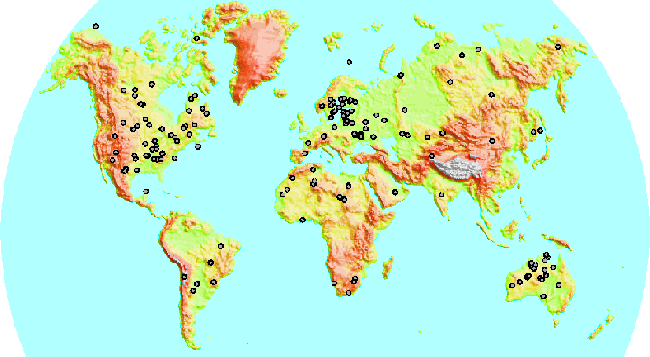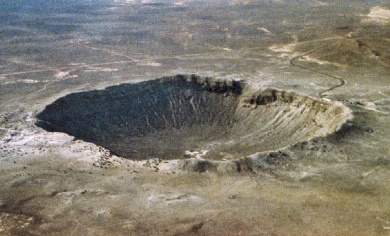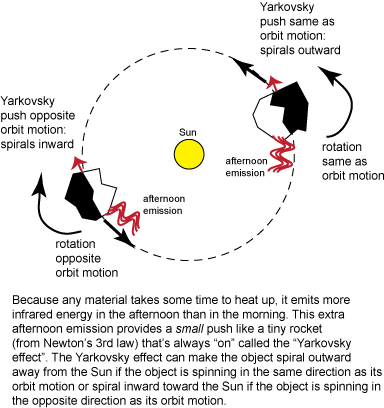
Some asteroids have orbits that cross the orbit of the Earth. That means that the Earth will be hit sometime. Recent studies have shown that the Earth has been hit an alarmingly large number of times in the past. One large impact is now thought to have contributed to the quick demise of the dinosaurs about 65 million years ago. What would be the effects of an asteroid hitting the Earth?

Known impact sites on the Earth's continents (from The Planetary and Space Science Centre). See also LPI's Terrestrial Impact Site for pictures of the craters.
What follows is a condensation of an excellent article by Sidney van den Bergh called "Life and Death in the Inner Solar System" in the May 1989 issue of the Publications of the Astronomical Society of the Pacific (vol. 101, pages 500-509). He considers a typical impact scenario of a 10-kilometer object with density = 2.5 times that of water, impacting at a speed of 20 kilometers/second. Its mass = 1.31 trillion tons (1.31 × 1015 kilograms). A 1-kilometer object has a mass = 1.31 billion tons.
On its way to the impact, the asteroid pushes aside the air in front of it creating a hole in the atmosphere. The atmosphere above the impact site is removed for several tens of seconds. Before the surrounding air can rush back in to fill the gap, material from the impact: vaporized asteroid, crustal material, and ocean water (if it lands in the ocean), escapes through the hole and follows a ballistic flight back down. Within two minutes after impact, about 105 cubic kilometers of ejecta (1013 tons) is lofted to about 100 kilometers. If the asteroid hits the ocean, the surrounding water returning over the hot crater floor is vaporized (a large enough impact will break through to the hot lithosphere and maybe the even hotter asthenosphere), sending more water vapor into the air as well as causing huge steam explosions that greatly compound the effect of the initial impact explosion.
There will be a crater regardless of where it lands. The diameter of the crater in kilometers is = 0.765 × (energy of impact in megatons TNT)(1/3.4). Plugging in the typical impact values, you get a 150-kilometer diameter crater for the 10-kilometer asteroid and a 20-kilometer diameter crater for the 1-kilometer asteroid. The initial blast would also produce shifting of the crust along fault lines.
 Meteor (Barringer) Crater in northern Arizona (about 1 kilometer across). Select here for a view from the rim. |
 Chicxulub Crater in Yucatan, Mexico (from the one that may have killed off the dinosaurs). |
Some values for the height of the tsunami at different distances from the impact site are given in the following table. The heights are given for the two typical asteroids, a 10-kilometer and a 1-kilometer asteroid.
| Distance (in km) | 10 km asteroid | 1 km asteroid |
|---|---|---|
| 300 | 1.3 km | 42 m |
| 1000 | 540 m | 18 m |
| 3000 | 250 m | 8 m |
| 10000 | 100 m | 3 m |
The steam blasts from the water at the crater site rushing back over the hot crater floor will also produce tsunamis following the initial impact tsunami and crustal shifting as a result of the initial impact would produce other tsunamis---a complex train of tsunamis would be created from the initial impact (something not usually shown in disaster movies).
The cooling is followed by a much more prolonged period of increased temperature due to a large increase in the greenhouse effect. The greenhouse effect is increased because of the increase of the carbon dioxide and water vapor in the air. The carbon dioxide level rises because the plants are burned and most of the plankton are wiped out. Also, water vapor in the air from the impact stays aloft for awhile. The temperatures are too warm for comfort for awhile.
In the early 1990s astronomers requested funding for an observing program called Spaceguard to catalog all of the near-Earth asteroids and short period comets. The international program would take 10 years to create a comprehensive catalog of all of the hazardous asteroids and comets. The cost for the entire program (building six special purpose telescopes and operation costs for ten years) would be less than what it costs to make a popular movie like Deep Impact or Armageddon.
In mid-1999 NASA and the US Air Force began a Near-Earth Object search program (now run by JPL) using existing telescopes to locate 90% of the NEOs larger than 1 kilometer in diameter in ten years. Near-Earth Objects are those objects that can approach the Sun to within 1.3 AU. The 1-kilometer diameter size is the lower limit of an impact having a global rather than just a regional effect. As of October 2024, the program has found 865 NEO asteroids larger than 1 kilometer in diameter and there are about 2438 "Potentially Hazardous Asteroids (PHAs)" with diameters greater than 150 meters and have orbits that can get to within 0.05 AU (7,480,000 km) of the Earth's orbit (see the NEO Discovery Statistics page for updates). NASA's “Eyes on Asteroids” website has a continually-updated visualization of the positions of all of the NEOs known. The "potential" in the PHA term does not mean the PHA will impact the Earth; there is just the possibility it could in the future, so we must monitor the PHA closely. To find out more about the United States' program, go to NASA's Asteroid and Comet Watch site and JPL's Asteroid Watch (site intended for the general public with educational materials to learn about asteroids) or the Center for Near Earth Object Studies (site with more in-depth information but not as glitzy as the Asteroid Watch site). The Center for Near Earth Object Studies website also has a chart and data on hundreds of fireball events since 1988 (including the Chelyabinsk airburst in 2013 and the airburst over the Bering Sea in December 2018 which had impact energies of 440 kilotons TNT and 173 kilotons TNT, respectively).
One process that affects the orbits of asteroids and, therefore, introduces uncertainty in whether a particular NEA will hit the Earth is the Yarkovsky effect. In the Yarkovsky effect, there is a slight mis-alignment of the energy emitted by the asteroid and the energy it receives from the Sun. Because any material takes some time to heat up, the asteroid's afternoon side emits more infrared energy than the morning side. The afternoon emission of infrared energy from solar heating is not pointed right at the Sun, so the thermal radiation from the asteroid is not exactly balanced by the solar photons. This results in a pushing that can move the asteroid inward toward the Sun or away from the Sun. If the asteroid is rotating in the same direction that it moves in its orbit around the Sun ("prograde rotation"), the asteroid will be pushed away from the Sun; if the asteroid is rotating in the opposite direction from its orbital motion ("retrograde rotation"), the asteroid will be pushed toward the Sun. The effect is very small but it is continually acting on the asteroid over many years, so it can have a measurable influence on the asteroid's motion.

Unfortunately for us, the Yarkovsky effect depends on all sorts of features about the asteroid itself that we do not know: things like the asteroid's size, mass, how the material in the asteroid responds to heat, and most importantly on the orientation of the asteroid's spin axis (remember the mis-alignment of the noon Sun energy input direction vs. the afternoon asteroid energy output direction). If the asteroid is tumbling about two or more axes, then the afternoon infrared radiation it emits from solar heating is randomly directed instead of being in one consistent direction. Without a consistent direction of the infrared emission, the Yarkovsky effect is eliminated. A related effect called the "YORP effect" arises from the non-uniform shape and reflectivity of various parts of the asteroid that can cause one side of the asteroid to be a better emitter of its infrared energy than another part. The YORP effect can speed up or slow down the asteroid's spin rate and also change the spin axis direction leading to a possible increase in the Yarkovsky effect. The OSIRIS-REx spacecraft has measured the increase in Bennu's rotation speed due to the YORP effect such that Bennu's rotation period is decreasing by one second every century (an hour every 360,000 years).
The surprise airburst of an asteroid over Chelyabinsk, Russia in February 2013 followed several hours later by the very close flyby of another but unrelated asteroid called 2012 DA14 were potent reminders that an impact can happen any time. Asteroid 2012 DA14 is a near-Earth stony asteroid about 50 meters in diameter that was discovered just several months before its close flyby of just 27,600 km from the Earth's surface, closer than even the ring of geosynchronous satellites. That was one we were prepared to observe. The smaller Russia asteroid was truly a surprise. The airburst of the 17-meter Russia asteroid released as much energy as nearly 500 kilotons of TNT 20-30 kilometers above the surface, knocking out windows for many kilometers around. If DA14 had hit, it would have released the energy equivalent to 2.4 megatons of TNT. Something like DA14 passes near the Earth every 40 years on average and an impact happens roughly once every 1200 years. Smaller objects are much more numerous, so something the size of the Russia asteroid impact the Earth roughly once every several decades. With most of the Earth's surface covered with oceans of water and humans concentrated in a small fraction of the land area, destructive impacts over population centers are fortunately rare.
Ground-based efforts to find potentially-hazardous asteroids are described in the previous section. The NEOWISE program that used the Wide-field Infrared Survey Explorer spacecraft to discover near-Earth objects in 2011 after the spacecraft's primary mission was completed showed that a space-based infrared telescope would find near-Earth objects more efficiently than any ground-based effort could. A special-purpose NEO search mission called "Sentinel" was proposed by the privately-funded B612 Foundation with a launch date in mid-2018. Fundraising for Sentinel was stopped in 2016 when B612 concluded that NASA's proposed NEOCam space telescope (now called “NEO Surveyor” launching in mid-2028) and the Large Synoptic Survey Telescope (renamed the “Vera C Rubin Observatory” with first light expected in 2025) would be able to find the 100-meter and larger asteroids that could hit Earth. NEO Surveyor will orbit at the Earth-Sun L1 Lagrange point, a gravitational balance point between Earth and the Sun.
A space-based infrared telescope like NEO Surveyor has a number of advantages over a ground-based search including it would have a wider search field that includes objects interior to the Earth's orbit as well as those outside of Earth's orbit, it would more easily find the dark near-Earth asteroids that are quite common, it could operate 24 hours per day, there would be less confusion from the background stars, and the infrared measurements of the asteroids would provide more accurate estimates of the asteroid sizes and reflectivity. Objects of special interest that get close enough to Earth can be studied with radar to get very precise orbit determinations along with rotation, shape, and surface properties measurements.
Asteroids that are on Earth-impact trajectories can be nudged out of the way by various techniques that are either precise and gradual long-term pulling or pushing or sudden and less precise impulses. Regardless of the technique, the key is to apply them while the asteroid is still quite far from the Earth so the nudge does not have to be as large. In the same way it is easier to change an arrow's path when it is just leaving the bow string than it is when the arrow is near its target, the farther away the asteroid is from the Earth when we apply the nudge, the easier it will be to change the asteroid's path. Despite what is portrayed in the movies, our current capabilities would require the nudge to be given while the asteroid is still several years out from the impact.
In the sudden impulse category we could simply run into the asteroid with a massive spacecraft. A sort of trial-run of such a technique was done successfully when the Deep Impact impactor ran into the nucleus of comet Tempel 1 (for scientific purposes discussed in a later section) in July 2005. That proved we could hit a small body from tens of millions of kilometers away. The Double Asteroid Redirection Test mission in 2022 was specifically designed to test the asteroid deflection technique by ramming a spacecraft into a small satellite asteroid, called Dimorphos, orbiting a larger Near Earth Object asteroid, called Didymos. Dydmos-Dimorphos are not potentially hazardous asteroids, so there was no chance that the collision would cause them to change their path and hit Earth in the future. Also, hitting a small object orbiting a larger body edge-on as seen from Earth would be much easier to detect a change in its motion from ground-based telescopes by measuring how much the orbit period changed. In the case of Dimorphos, DART reduced Dimorphos' orbit period by a significantly large 33 minutes when it hit the asteroid at 6.5 km/sec (over 22,500 kph) in September 2022. (See the DART team's summary of its success.) The European Space Agency's Hera mission launched in October 2024 will rendezvous with Dydymos-Dimorphos in December 2026 to study up-close the effects of DART's impact.
The sudden impulse technique works if the asteroid is solid rock or metal and not a rubble pile as some (most?) asteroids appear to be. A rubble pile asteroid (fragmented rock) would efficiently absorb the shock without changing course. We also would not want to risk creating multiple large fragments that would later hit the Earth.
The method loved by movie makers—detonating nuclear warheads—is in the sudden impulse category. The movies show the warheads striking the asteroid at high speed and blowing it up. Unfortunately, our current warheads cannot survive impact speeds as high as what they show in the movies. Actual nuclear detonations would need to be either just off the asteroid's surface, strongly heating one part of the asteroid and giving the asteroid the needed nudge from the recoil, or from devices embedded within the asteroid with the hope of fragmenting the asteroid enough so that only a much smaller amount of the asteroid reaches the Earth. Like the spacecraft impactor option, how well the nuclear option works depends on the asteroid's composition and structure.
In the gradual long-term applied force category is a technique that has a spacecraft moving alongside the asteroid and adjusting the asteroid's pass by the gravitational pull of the spacecraft, a "slow-pull gravity tractor". The spacecraft gravity tractor method does not depend on the asteroid's structure, composition, or rotation. However, the acceleration supplied by the spacecraft's gravity is extremely small, so it would need to act over a long time. Other examples in this category include pushing the asteroid with an ion beam, attaching a rocket (chemical or ion) engine to the asteroid, focusing solar energy to enhance the Yarkovsky effect, and a mass driver on the asteroid that ejects small pieces of the asteroid into space to give the slow steady recoil push. Of course, it is always possible to use multiple techniques to deflect the asteroid and the gradual long-term applied force techniques would be most useful if they supplied small course corrections after the more powerful sudden impulses were used. All of these techniques would require an unprecedented amount of cooperation and agreement among the nations in planning and implementing the deflection attempts and deciding when to act and also what happens if the impact site shifts from one country to another because the deflection attempt was not totally successful.
The near-Earth asteroids are the most worrisome ones for possible impacts but they could also be potentially very beneficial to us if we could mine them for rare metals and use the asteroids as convenient stepping stones to manned exploration of the solar system, especially traveling to Mars. The near-Earth asteroids are relatively abundant in heavy metals like iron and nickel and the platinum-group metals (platinum, palladium, rhodium, ruthenium, osmium, and iridium) used in modern technology. A kilometer-diameter asteroid would have several trillion dollars worth of these materials. In fact, all of the heavy metals (iron on up) in the Earth's crust came from asteroid impacts after the Earth differentiated---the Earth's original supply from its formation is in the Earth's core. For some near-Earth asteroids it would take less fuel to travel to, land on, and return to Earth than would a roundtrip to the Moon's surface. The round-trip asteroid trip would take several months and provide the crucial experience needed to prepare for the more difficult over two-year round-trip to Mars. This experience would include testing of methods of extracting water from the asteroid's minerals, recycling the water for long-duration flights, and using the water as a shield from solar wind, solar eruptions, and cosmic rays. The water from the asteroids could also be broken down into oxygen and hydrogen to be used as rocket fuel.
In addition to the websites about Near Earth Objects linked to above, another excellent resource to learn more about the topics discussed in this section is Don Yeomans' book Near-Earth Objects: Finding Them Before They Find Us, published in 2013. Yeomans was the manager of NASA's Near-Earth Object Program and supervisor of the Solar System Dynamics Group.
![]() Go back to previous section --
Go back to previous section --
![]() Go to next section
Go to next section
last updated: October 31, 2024